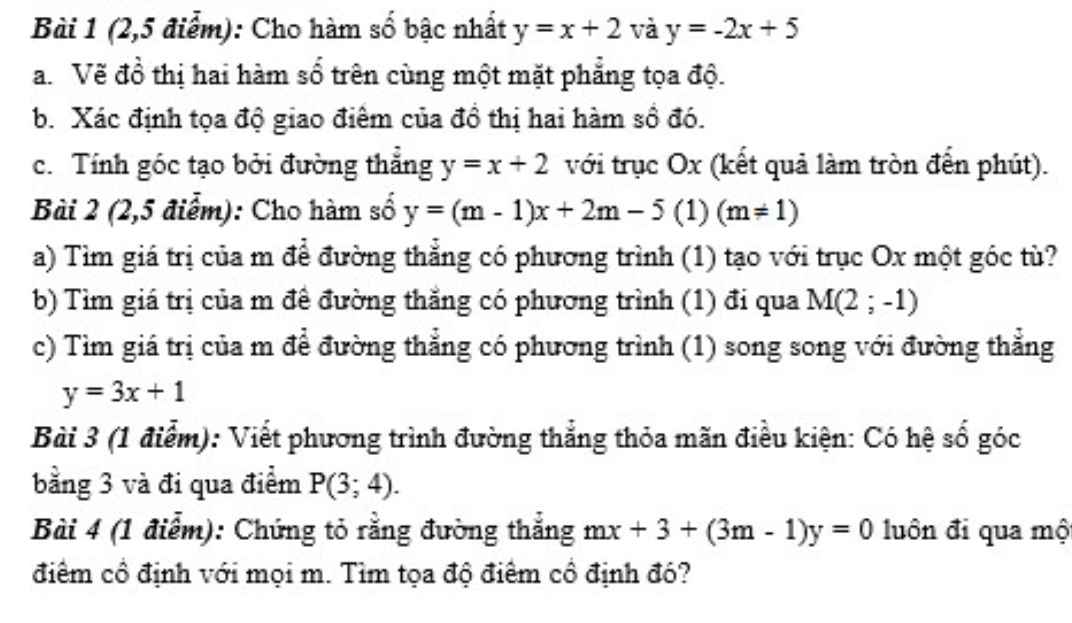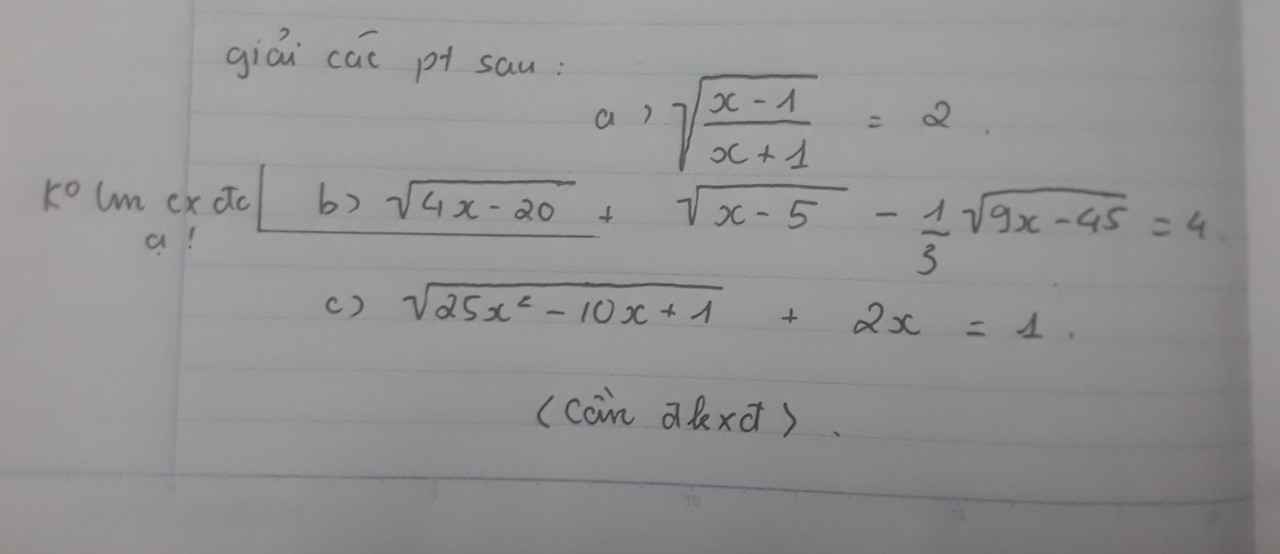
Hãy nhập câu hỏi của bạn vào đây, nếu là tài khoản VIP, bạn sẽ được ưu tiên trả lời.


c. \(\left(x+2\right)^4-6\left(x+2\right)^2+5=0\)
\(\Leftrightarrow\left(x+2\right)^4-\left(x+2\right)^2-5\left(x+2\right)^2+5=0\)
\(\Leftrightarrow\left(x+2\right)^2\left[\left(x+2\right)^2-1\right]-5\left[\left(x+2\right)^2-1\right]=0\)
\(\Leftrightarrow\left[\left(x+2\right)^2-1\right]\left[\left(x+2\right)^2-5\right]=0\)
\(\Leftrightarrow\left(x+3\right)\left(x+1\right)\left(x+2+\sqrt{5}\right)\left(x+2-\sqrt{5}\right)=0\)
\(\Leftrightarrow\left[{}\begin{matrix}x+3=0\\x+1=0\\x+2+\sqrt{5}=0\\x+2-\sqrt{5}=0\end{matrix}\right.\Leftrightarrow\left[{}\begin{matrix}x=-3\\x=-1\\x=-\sqrt{5}-2\\x=\sqrt{5}-2\end{matrix}\right.\)
Vậy: Phương trình có tập nghiệm \(S=\left\{-3;-1;-\sqrt{5}-2;\sqrt{5}-2\right\}\)


a, \(A=\dfrac{7\sqrt{x}+9}{\sqrt{x}+1}=\dfrac{7\left(\sqrt{x}+1\right)+2}{\sqrt{x}+1}=7+\dfrac{2}{\sqrt{x}+1}\)
Ta có : \(\sqrt{x}+1\ge1\Rightarrow\dfrac{2}{\sqrt{x}+1}\le2\)
\(\Rightarrow A=7+\dfrac{2}{\sqrt{x}+1}\le7+2=9\)
Dấu ''='' xảy ra khi x = 0
Vậy GTLN của A bằng 9 tại x = 0

Bài 1:
b: Tọa độ giao điểm là:
\(\left\{{}\begin{matrix}x+2=-2x+5\\y=-x+2\end{matrix}\right.\Leftrightarrow\left\{{}\begin{matrix}x=1\\y=1\end{matrix}\right.\)
Bài 1:
\(b,\) PTHDGD là \(x+2=-2x+5\Leftrightarrow x=1\Leftrightarrow y=3\Leftrightarrow A\left(1;3\right)\)
Vậy A(1;3) là giao điểm 2 đths
\(c,\) PT giao Ox là \(y=0\Leftrightarrow x=-2\Leftrightarrow B\left(-2;0\right)\Leftrightarrow OB=\left|-2\right|=2\)
PT giao Oy là \(x=0\Leftrightarrow y=-2\Leftrightarrow C\left(0;-2\right)\Leftrightarrow OC=\left|-2\right|=2\)
Do đó \(\tan\widehat{OBC}=\dfrac{OC}{OB}=1\Leftrightarrow\widehat{OBC}=45^0\)
Mà hệ số a của đt >0 nên góc tạo bởi đt với Ox là góc nhọn có sđ 45o


b: Xét tứ giác ACOD có
I là trung điểm của CD
I là trung điểm của OA
Do đó: ACOD là hình bình hành
mà OC=OD
nên ACOD là hình thoi
Xét ΔCMO có
CA là đường trung tuyến
CA=MO/2
Do đó: ΔCMO vuông tại C
hay CM là tiếp tuyến của (O)


a)\(đkx\ge1,x\ne-1\)
\(\sqrt{\dfrac{x-1}{x+1}}=2\)
\(\Leftrightarrow\dfrac{x-1}{x+1}=4\)
\(\Leftrightarrow x-1=4x-4\)
\(\Leftrightarrow x=1\)(nhận)
Vậy S=\(\left\{1\right\}\)
c)đk\(25x^2-10x+1=\) \(\left(5x-1\right)^2\ge0\Leftrightarrow x\ge\dfrac{1}{5}\)
\(\sqrt{25x^2-10x+1}+2x=1\)
\(\Leftrightarrow\sqrt{\left(5x-1\right)^2}+2x=1\)
\(\Leftrightarrow5x-1+2x=1\)
\(\Leftrightarrow x=\dfrac{2}{7}\)(nhận)
Vậy S=\(\left\{\dfrac{2}{7}\right\}\)
c: Ta có: \(\sqrt{25x^2-10x+1}+2x=1\)
\(\Leftrightarrow\left|5x-1\right|=1-2x\)
\(\Leftrightarrow\left[{}\begin{matrix}5x-1=1-2x\left(x\ge\dfrac{1}{5}\right)\\5x-1=2x-1\left(x< \dfrac{1}{5}\right)\end{matrix}\right.\Leftrightarrow\left[{}\begin{matrix}x=\dfrac{2}{7}\left(nhận\right)\\x=0\left(nhận\right)\end{matrix}\right.\)

a: Ta có: \(\sqrt{x^2-4x+4}=\sqrt{4x^2-12x+9}\)
\(\Leftrightarrow\left|x-2\right|=\left|2x-3\right|\)
\(\Leftrightarrow\left[{}\begin{matrix}2x-3=x-2\\2x-3=2-x\end{matrix}\right.\Leftrightarrow\left[{}\begin{matrix}x=1\\x=\dfrac{5}{3}\end{matrix}\right.\)
c: Ta có: \(\sqrt{4x^2-4x+1}=\sqrt{x^2-6x+9}\)
\(\Leftrightarrow\left|2x-1\right|=\left|x-3\right|\)
\(\Leftrightarrow\left[{}\begin{matrix}2x-1=x-3\\2x-1=3-x\end{matrix}\right.\Leftrightarrow\left[{}\begin{matrix}x=-2\\x=\dfrac{4}{3}\end{matrix}\right.\)










Câu 4:
ĐKXĐ: \(\left\{{}\begin{matrix}2x-3>=0\\23-2x>=0\end{matrix}\right.\)
=>\(\left\{{}\begin{matrix}x>=\dfrac{3}{2}\\x< =\dfrac{23}{2}\end{matrix}\right.\)
=>3/2<=x<=23/2
\(A=\sqrt{2x-3}+\sqrt{23-2x}\)
=>\(A^2=1\cdot\sqrt{2x-3}+1\cdot\sqrt{23-2x}< =\left(1^2+1^2\right)\cdot\left(2x-3+23-2x\right)\)
=>\(A^2< =2\cdot20=40\)
=>\(-2\sqrt{10}< =A< =2\sqrt{10}\)
Vậy: \(A_{max}=2\sqrt{10}\) khi 2x-3=23-2x
=>4x=26
=>x=6,5